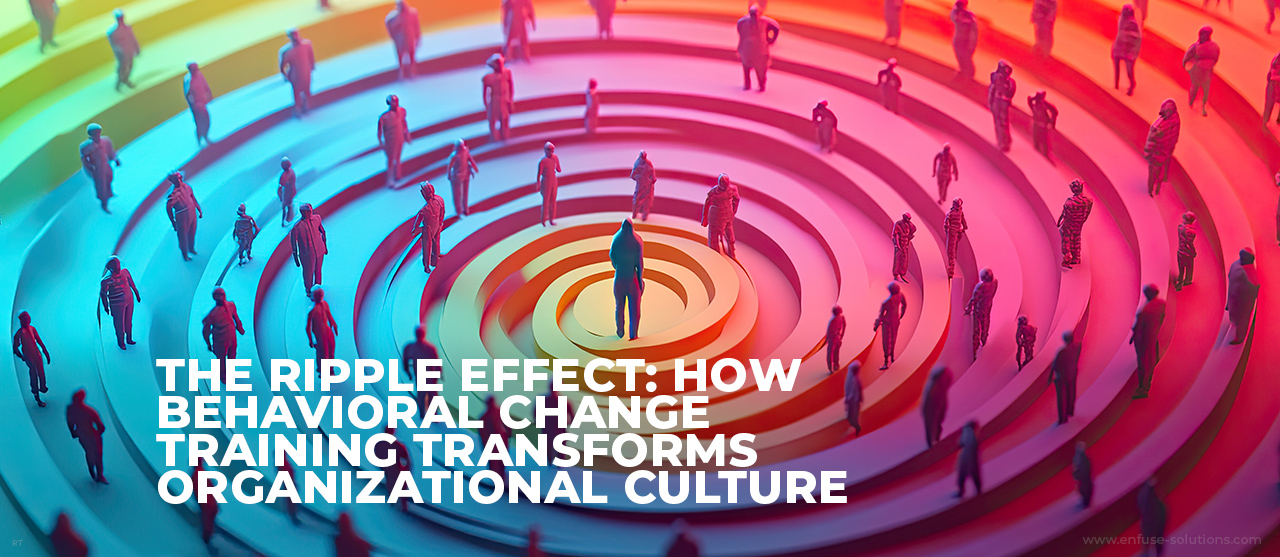
In the rapidly evolving business landscape, cultivating a vibrant organizational culture is crucial for achieving sustainable success. The effectiveness of an organization is not just rooted in its systems, processes, or technology, but also in the behavior and mindset of its employees. Behavioral change training, once seen as an ancillary initiative, has now emerged as a pivotal tool in transforming organizational culture. It enables businesses to align individual behavior with broader organizational goals, driving growth, innovation, and employee satisfaction.
Why Behavioral Change Training Matters?
Organizations often focus on technical proficiency, overlooking the importance of employee behavior, mindset, and interpersonal dynamics. However, behavior shapes how employees interact, solve problems, collaborate, and contribute to organizational goals. When employees’ behaviors are aligned with the company’s vision, values, and culture, the organization reaps significant advantages, such as:
- Boosted Productivity: Behavioral change training helps employees develop more effective work habits and improves collaboration within teams.
- Higher Employee Engagement: When employees feel recognized and appreciated, they become more committed and engaged in their roles.
- Greater Innovation And Creativity: Encouraging open communication and teamwork paves the way for fresh ideas and innovative solutions.
Gallup’s 2023 State of the Global Workplace report reveals that only 23% of employees globally are engaged at work, highlighting the need for not just enhancing individual performance but also reshaping organizational culture to keep employees motivated.
The key question is: how can organizations successfully implement these behavioral changes and embed them within their culture?
The Science Behind Behavioral Change
Behavioral change training involves more than simply altering behaviors. It’s deeply rooted in psychological principles such as the behavioral theory, which emphasizes that behavior is learned and can be unlearned through reinforcement, repetition, and feedback. It also takes into account emotional intelligence, social learning theory, and cognitive-behavioral approaches.
The process of change can be difficult; however, systematic training programs enable employees to identify their habits, question their beliefs, and embrace more effective behaviors. When combined with consistent feedback and support from leadership, this structured learning fosters enduring transformation.
The Link Between Behavioral Change And Culture Transformation
Behavioral change training transforms organizational culture by:
1. Enhancing Employee Engagement: Employee engagement increases dedication and job happiness, which benefits the success of the business as a whole. Training that promotes positive Behaviors helps employees feel valued and supported, resulting in higher engagement levels.
2. Promoting Collaboration: Open communication, active listening, and empathy are vital for fostering collaboration. Behavioral change training helps dismantle silos and enhances teamwork across departments.
3. Driving Innovation: Encouraging behavioral shifts cultivates creativity and a focus on solutions. By fostering a culture of continuous improvement, organizations can nurture adaptability and innovation.
4. Improving Leadership: Effective leadership is essential to organizational culture. Behavioral change training enhances leadership skills, including emotional intelligence, conflict resolution, and decision-making.
5. Boosting Employee Retention: Employees who experience personal and professional growth are less likely to leave. Training that promotes positive behavioral changes creates a supportive environment, leading to reduced turnover.
The Ripple Effect Of Behavioral Change Training
The impact of behavioral change training reaches far beyond individual employees, creating a ripple effect that influences entire teams and organizations. Here’s how:
1. Strengthened Leadership: Leaders are typically the first to engage in behavioral change training, setting the organization’s tone. A 2023 report from DDI’s Global Leadership Forecast found that companies investing in leadership development see 6.2% higher revenue growth than their competitors. When leaders adopt positive behaviors like active listening and empathy, it fosters a more supportive and collaborative environment for their teams.
2. Enhanced Employee Collaboration: Behavioral training focuses on essential soft skills such as communication and conflict resolution, which promote teamwork and collaboration. According to Harvard Business Review, organizations with high collaboration levels are five times more likely to perform well. As employees build trust and stronger relationships, they are more likely to share ideas and work towards common goals.
3. Increased Employee Engagement And Retention: Organizations that prioritize employees’ personal and professional growth experience significant improvements in engagement and retention. A LinkedIn report indicates that 94% of employees are likely to stay longer with companies that invest in their development. By offering behavioral change training, companies demonstrate their commitment to employee growth, fostering loyalty and dedication.
4. Improved Organizational Agility: Behavioral change training promotes adaptability, essential in today’s fast-paced business environment. A 2024 Deloitte study revealed that 80% of executives consider agility vital for long-term success. Employees who learn to embrace change and think critically are more resilient, enabling organizations to innovate and adapt swiftly, gaining a competitive edge.
5. A Culture Of Continuous Improvement: Behavioral change training instills a mindset of continuous improvement. Employees are encouraged to reflect on their actions, seek feedback, and make necessary adjustments. This shift from a fixed to a growth mindset fosters a learning culture. Gallup’s 2022 report states that organizations prioritizing learning and development see a 14.9% lower turnover rate and 21% higher profitability.
Measuring The ROI Of Behavioral Change Training
As with any strategic investment, it’s essential to measure the return on investment (ROI) for behavioral change training. While quantifying changes in behavior may seem intangible, several metrics provide insights into the training’s effectiveness:
- Employee Engagement Scores: Post-training surveys can gauge shifts in employee engagement and satisfaction.
- Performance Metrics: Improvements in productivity, quality of work, and team collaboration can be linked to Behavioral changes.
- Retention Rates: Tracking retention before and after implementing training programs reveals how much the training impacts employee loyalty.
- Profitability: Higher engagement and collaboration directly contribute to an organization’s financial performance.
Moreover, companies that implement effective behavioral training programs see a significant increase in their CAGR (Compound Annual Growth Rate). According to Global Market Insights, the Employee Experience Management Market was valued at USD 6.1 billion in 2023 and is projected to grow at a compound annual growth rate (CAGR) of over 6.5% from 2024 to 2032.
Conclusion
In an era where innovation, collaboration, and adaptability are key to long-term success, behavioral change training emerges as an indispensable tool for organizations aiming to transform their culture. Its ripple effect touches every level of the business, from leadership to frontline employees, creating a thriving, high-performance culture that drives sustained growth.
The statistics speak for themselves: organizations that prioritize behavioral change training enjoy higher engagement, stronger leadership, and better financial outcomes. As the workplace evolves, investing in these transformative programs is not just a strategic choice – it’s a necessary one.
Get in touch today and experience the EnFuse Effect — a ripple that transforms your tomorrow.

















Comment